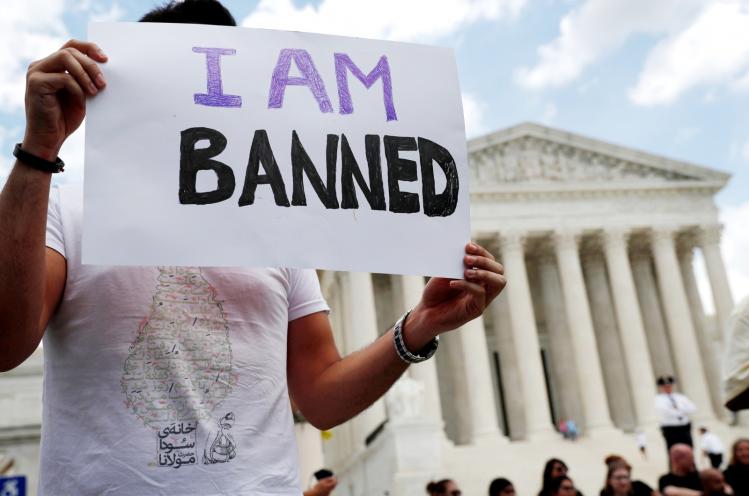
Washington is filled with bright people kept busy in the task of finding a legal basis to enable Donald Trump’s biases and bad temper. The conservative majority of the Supreme Court has done its part with its ruling in Trump v. Hawaii, better known as the travel ban case.
To permit the president’s ban on travel from five predominantly Muslim countries, the justices had to virtually exclude widespread concern and strong evidence that it was crafted to fulfill the president’s often-stated desire to bar Muslims from entering the United States. Led by Chief Justice John Roberts, the five-member majority disposed of the obvious First Amendment concerns by giving precedence to the broad presidential authority to exclude immigrants who “would be detrimental to the interests of the United States,” as a 1952 law put it.
The justices decided to overlook Trump’s election-campaign contempt for Islam as outside the scope of his official duties, but they were hard-pressed to explain away continued evidence of that contempt following his inauguration. Nonetheless, they did, accepting the government’s argument that the travel ban was based on a rigorous compliance review rather than on the president’s view of Muslims.
Except that there is strong evidence the ban was crafted with the intent of finding a way to justify Trump’s discriminatory intent. Both Roberts’s majority ruling and Justice Sonia Sotomayor’s dissenting opinion note that a presidential adviser—not named, but it’s Rudy Giuliani—admitted this publicly. Roberts describes it:
In a television interview, one of the President’s campaign advisers explained that when the President “first announced it, he said, ‘Muslim ban.’ He called me up. He said, ‘Put a commission together. Show me the right way to do it legally.’ The adviser said he assembled a group of Members of Congress and lawyers that “focused on, instead of religion, danger.”
The kind of manipulation that Trump or Giuliani might have used to come out on top in New York’s 1980s tabloid gossip wars will work on the U.S. Supreme Court, it turns out. “But because there is persuasive evidence that the entry suspension has a legitimate grounding in national security concerns, quite apart from any religious hostility, we must accept that independent justification,” Roberts wrote.
It’s okay for government to discriminate against immigrants on the basis of religion as long as it can articulate some other justification for it. And, as Roberts wrote of Trump’s executive order, “The text says nothing about religion.”
That contrivance did not impress the U.S. Catholic bishops. “We are disappointed in the Court’s ruling because it failed to take into account the clear and unlawful targeting of a specific religious group by the government,” Archbishop Joseph Kurtz, chairman of the bishops’ committee on religious freedom, and Bishop Joe Vasquez, who heads the committee on migration, said in a joint statement.
***
Trump did not make it easy for the Roberts majority to uphold his ban. As Sotomayor noted in her dissent, even as the case was being argued in the courts, Trump continued to signal that his true intent was to follow through on the discriminatory policies he pledged during his campaign.
Trump regretted that he had to “water down” his travel ban, tweeting that he wanted a “much tougher version” of it. On September 15, 2017, he tweeted, “The travel ban into the United States should be far larger, tougher and more specific-but stupidly, that would not be politically correct.” Sotomayor also took note of Trump’s November 29, 2017 re-tweet of three anti-Muslim videos called “Muslim Destroys a Statue of Virgin Mary!”; “Islamist mob pushes teenage boy off roof and beats him to death!”’; and “Muslim migrant beats up Dutch boy on crutches!”
Those videos were initially tweeted by a British political party whose mission is to oppose “all alien and destructive politic[al] or religious doctrines, including . . . Islam.” When asked about these videos, the White House Deputy Press Secretary connected them to the Proclamation, responding that the “President has been talking about these security issues for years now, from the campaign trail to the White House” and “has addressed these issues with the travel order that he issued earlier this year and the companion proclamation.”
It’s not clear what more proof would be needed to show that Trump had long planned to stop Muslims from migrating to the United States and had signed an executive order designed to put him as close to that goal as he could possibly get, so far. As the U.S. Catholic bishops said in their amicus brief, “Such blatant religious discrimination is repugnant to the Catholic faith, core American values, and the United States Constitution. It poses a substantial threat to religious liberty that this Court has never tolerated before and should not tolerate now.”
In some ways, the most ominous part of the case is the concurring opinion from Justice Anthony Kennedy, the swing vote. In backing the majority opinion, he tacked on a statement asserting that while the actions of government officials are often not subject to judicial review, “that does not mean those officials are free to disregard the Constitution and the rights it proclaims and protects.” He adds that it is “an urgent necessity that officials adhere” to First Amendment protections of freedom of belief and expression “in all their actions, even in the sphere of foreign affairs.” For, Kennedy adds, “An anxious world must know that our Government remains committed always to the liberties the Constitution seeks to preserve and protect, so that freedom extends outward, and lasts.”
Such words warn we live in a dangerous time—all the more so when the Supreme Court of the United States sees what’s wrong but looks away.
Please email comments to [email protected] and join the conversation on our Facebook page.
Previous Story
A Saint Born of Blood
Next Story
‘A Party of Friends’
